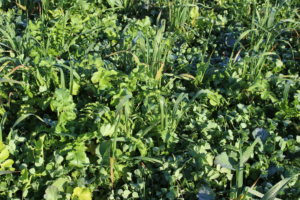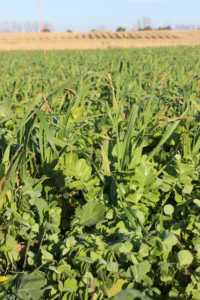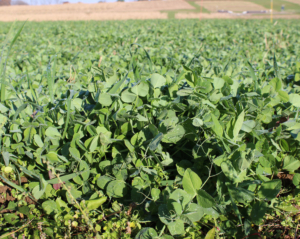Penn State Researcher Helps Farmers Choose the Best Cover Crop Mix
Nutrient pollution remains a major challenge for the Chesapeake Bay, but planting cover crops may be one of the strongest best management practices that farmers can use to reduce their impact.
Dr. Jason Kaye of Penn State has spent a decade researching cover crop species individually and in mixes. He wanted to study cover crops that farmers were already adopting in order to understand how benefits of some species could make up for the shortcomings of others.
Cover crops can either reduce nitrogen leaching or increase the supply of nitrogen to cash crops, but they cannot excel at both. Kaye wanted to see if farmers could balance nitrogen-fixing and nitrogen-scavenging capabilities by planting different cover crop species together.
Understanding why farmers use cover crops

Researchers tested mixed-species cover crop stands such as this one to see if they could balance the nitrogen-fixing and nitrogen-scavenging capabilities of individual species. Individually, cover crop species excel at either reducing nitrogen leaching or increasing nitrogen supply to cash crops. But they fail to excel at both simultaneously. Credit: Catalina Mejia / Penn State
Cover crops are used in between plantings of cash crops in order to increase the nitrogen intake to or decrease nitrogen leaching from cash crops that are planted after or before.
Before cash crops are planted, cover crops are mowed, killing the plants and leaving behind their rich troves of nitrogen for future plants to absorb. As the cover crops break down, microbes in the soil make the nitrogen available to roots of future cash crops, like corn.
“The farmers understand this mechanism quite well,” explained Kaye. “Organic farmers especially are thinking about recycling nutrients.”
Choosing the right cover crops
Kaye wanted to choose species for the study that are already used by farmers and that come from a range of plant types. Then, he developed mixes that would balance the nitrogen cycling properties of the individual species.
He chose two Brassica species, canola and tillage radish. Both of these species don’t host mycorrhiza, the microbe communities that form mutualistic relationships at the plants’ roots. Despite this downside, radishes are often planted because their tubers are thought to break up soil layers and allow more water to filter into the soil, and canola flowers early and attracts pollinators.
They also experimented with two legume species – clover and pea. Both legumes are known for fixing atmospheric nitrogen. Finally, he chose two grasses, oat and rye, because of their ability to prevent nitrogen leaching.
Each plant has a distinct carbon to nitrogen ratio in its tissue. Plants like legumes have a low carbon to nitrogen ratio, so when microbes break down their tissues, their nitrogen needs are satiated and there’s leftover nitrogen in the plant tissues that degrade in the soil for later cash crops to use.
In plants with a high carbon-to-nitrogen ratio, like grasses, microbes break down the tissue but it does not satiate their need for nitrogen. So the microbes take nitrogen from the soil, leaving less for the corn and other cash crops planted there later.
In order to measure these nitrogen cycles, Kaye’s team took a multi-pronged approach, analyzing nitrogen in the plants and in the soil. To analyze the nitrogen delivered to the cash crops, like corn, they cut down all of the above-ground corn plants and analyzed the biomass for nitrogen concentrations. Those numbers were compared to nitrogen calculations from control plots that weren’t planted with cover crops.
To measure the amount of nitrogen leaching from the soil into water, the team collected water samples in a couple ways. At some of the plots, they buried buckets and left holes in the lids that would allow groundwater to percolate and collect in the buckets. In other plots, they buried positively charged beads that extract passing nitrogen from the soil.
Understanding how the mixtures work for farmers
Some plots were planted with just one species, like pea plants, and other plots were planted with a mixture. The team tested each grass, legume, and Brassica species as a monoculture, and tested them as mixtures designed for specific goals.

Cover crop mixtures including legumes that include cereal rye (shown here) dramatically decreased pollution because grasses establish root biomass that holds nitrogen and provides microbial activity in the soil. Credit: Catalina Mejia / Penn State
Following Kaye’s hypotheses about how the plants would manage nitrogen, legume plots increased the amount of nitrogen available to cash crops. Specifically, plots covered with pea plants provided 40 kilograms per hectare more nitrogen to corn planted there later than fallow plots, or plots with no cover crops.
Also in line with their hypotheses, plots planted with grasses tended to have less nitrogen. They found that plots planted with all rye had 40 kilograms per hectare less nitrogen available to corn than fallow plots.
One of the mixtures, containing pea, rye, and clover, was chosen for its nitrogen management strengths, specifically designed to be planted in between wheat and corn cycles to increase the amount of nitrogen available to corn. The team was surprised by how effective the rye grasses were at preventing nitrogen leaching in this mixture.
“We knew rye would be very good at nitrogen retention, and we expected peas to be good at supply,” explained Kaye, “but what surprised me about the mix was that just a little rye in the mixture – as little as 20% – would achieve 90% of the leaching reduction.”
In short, they found that adding a little grass to a mix dominated by legumes allowed for nitrogen delivery to the cash crops while still reducing leaching. “Just a little bit of rye was almost as good as the rye monoculture at reducing leaching,” Kaye added.
They also created a mixture containing oat and radish meant for farmers to die from low temperatures in the fall instead of being mowed in the spring, while still preserving the benefits of the cover crops. “This gives farmers tools for spring management,” explained Kaye. “When farmers have to kill cover crops in the spring, that delays planting cash crops. Killing cover crops in the fall makes it easier to get an early start in the spring.”
The team found that this mixture was good at reducing leaching, even after the tissue from the cover crops was dead. In monocultures of oat and radish, the team found that these plants were good at rapidly absorbing nitrogen into their tissues in the fall, so even if they died in the winter, they prevented leaching.
The team also tested mixtures designed for weed suppression and to attract pollinators. The purpose of all four mixtures was to help farmers tackle complex problems, but Kaye notes that monocultures can still be useful for individual goals. “I don’t think there’s anything wrong with [monocultures]. When you get more diverse goals, or multiple goals, the mixtures just start to make a lot more sense.”
Expanding cover crops across the Chesapeake Bay
Kaye is eager to help farmers find cover crops that work for their goals. Although their experiment was run on an organic farm, he thinks that inorganic farmers can benefit greatly from cover cropping too. The challenge will be communicating what organic farmers already understand to a wider audience of non-organic farmers. “We’re always looking for new ways to translate it,” said Kaye.

Legume monocultures such as medium red clover and Austrian winter pea (shown here) increased nitrogen uptake in cash crops the most but weren’t as effective at preventing nitrogen leaching from fields as grasses, such as cereal rye and summer oats. Credit: Catalina Mejia / Penn State
He is excited to continue working with farmers and design mixtures of cover crops that the farmers are already using. “The species chosen [in this study] will be interesting to farmers because they were co-designed with farmer collaborators,” explained Kaye. He added that engaging with the farmers in this way “makes this project relevant.”
In the meantime, Kaye is eager to use his findings to fuel support for cover crops as a best management practice (BMP) for Bay health. “Cover crops are a top-five BMP for the Bay right now. Farmers are adopting cover cropping as a best practice all over the watershed and they’re looking for information about what crop mixtures are the best.”
He elaborated that cover cropping “stands up there with riparian buffers and no-till as key BMPs that will have to be employed to improve Bay water quality,” especially in Pennsylvania. Kaye added, “I don’t think we can meet a [Total Maximum Daily Load] without cover crops.”
Kaye is looking forward to continuing to provide scientific backing to different cover crop mixtures and help farmers make the best choices for their farms. “Hopefully farmers see this as an opportunity to plant mixes that help them meet their goals and also provide ecosystem services to the Bay.”
